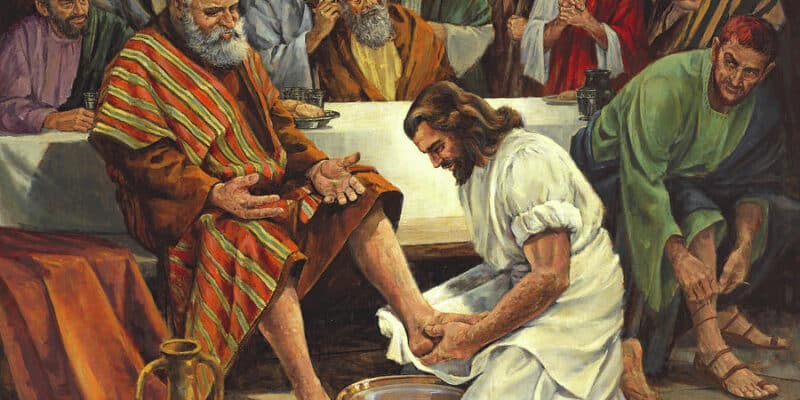
HE GETS US: Holy Thursday, the Washing of the Feet, and Ancient Tradition
As is usually the case, if one makes what is an initially jarring change to something, if one just lets enough time pass, people will forget altogether the truth and the actual point of the original.
This is the case with the ritual of the Washing of the Feet at Catholic Mass, which was once done in a separate place altogether–not even as a part of the Mass.
It was never meant to become the distraction or show it has become. One of my readings disclosed that one priest had door prizes for anyone volunteering for the ritual. It is just one of dozens and dozens of examples I have come across where either the Mass as a whole or some part of it has been turned into a joke. This is not the cross on Calvary. This is not the Holy Sacrifice of the Mass. This is not Catholic.
It is also not done in the Traditional Latin Mass. No room or place for such “creative license.”
The official statement of the New Order Catholicism ushered in by Annibale Bugnini (look him up!), the aftermath of Vatican II, and Pope Paul VI reads as follows:
Although the rubric in the Roman Missal refers only to men (#11 in the section on the Mass of the Lord’s Supper), the United States Conference of Catholic Bishops, as indicated in their liturgy committee’s statement cited above (and even Pope Francis by his own example) emphasize the significance of “the service that should be given by all the faithful to the Church and to the world” (#4, statement). Therefore, the variation and custom of having both men and women participate in the washing of the feet “is an understandable way of accentuating the evangelical command of the Lord, ‘who came to serve and not to be served,’ that all members of the Church must serve one another in love” (#5, statement). Thus, both men and women, including children, may have their feet washed as well as participate by washing another’s feet.
It all sounds so nice, and frankly, it would be fine for me personally as long as it included the points Scott McKay and I made in the aftermath of the “He Gets Us” ad during the Super Bowl, both of which I link in this article. Interpreted that way, it rightly includes our non-Catholic friends as well.
But that’s not what happens when random changes to tradition take place. I’ll say it again: As is usually the case, if one makes what is an initially jarring change to something, if one just lets enough time pass, people will forget altogether the truth and the actual point of the original.
What you have here is the slope slipping over the years, where now a truly Traditional Catholic is forced to appear prudish and intolerant. We’ve gone from something that could have been acceptable for all to something absolutely heretical concerning Tradition and Jesus Christ as Sovereign Priest. This latest (r)evolution by the Modernist Church has certainly allowed heretical commercials like the “He Gets Us” campaign to cause even more confusion among the flock and, as my case proved, to bring about the loss of a family member or two after their disagreement with what article I posted.
In 2015, one of my favorite Traditional Catholic commentators, Peter Kwasniewski, actually went beyond the strict liturgical purpose of the washing ritual. He said much in the way as what Scott McKay wrote in the aftermath of the airing of the “He Gets Us” commercial during the Super Bowl. We find this in Scripture as well, namely in St Paul, 1 Timothy 5:10. It involves the servant-leader aspect of the ritual:
First, we must recognize that Our Lord’s washing of the feet has a double aspect to it, which, it seems to me, accounts for some of the confusion we have managed to introduce by not thinking through how these two aspects are related. One aspect is the washing of the apostles’ feet at their ordination and the first Mass. Here, the accent is definitely placed on the apostolic college as the kernel of the new ministerial priesthood of the new covenant. The other aspect, of course, is the washing of the feet as a symbol of serving one’s fellow man in general, even as Christ came not to be served but to serve and to give his life as a ransom for many.
The bold is where Kwasniewski and McKay intersect. This is true, and certainly Kwasniewski’s article thesis isn’t expansive, but to be clear, Jesus was not subservient to the sin or the sinner. Never. Not ever. He tolerated none of it. He was merciful, yes, but coupled with every act of mercy was this clear command–go and sin no more.
In my February take on the “He Gets Us” campaign, among other things, I wrote the following:
Dare I say it, this line of thinking and false teaching seems to be the great delusion of which God speaks in Scripture. Brotherhood, unity, togetherness–all things Francis focuses on exponentially more than even a mentioning of Jesus Christ as Lord and Savior in much of his writings. It is the Masonic religion. It is the religion of Antichrist.
Again, I invite you to look up Annibale Bugnini.
After Bugnini, research even a little on how far the goalpost has moved from the foot washing ritual’s original intent to what Francis has done to it, and you may see the seriousness and legitimacy of my point.
Bishop Athanasius Schneider’s comments in a 2016 interview came with even more fire and clarity. In this age of the gray pulpit of Francis, such black and white assurance is what Catholics need.
A typical Catholic parish priest should know well the perennial sense of the Catholic faith, the perennial sense as well of the laws of the Catholic liturgy and, knowing this, he should have an interior sureness and firmness. He should always remember the Catholic principle of discernment: “Quod semper, quod ubique, quod ab omnibus”, i.e. “What has been always, everywhere and from all” believed and practiced.
The categories “always, everywhere, all” are not to be understood in an arithmetical, but in a moral sense. A concrete criterion for discernment is this: “Does this change in a doctrinal affirmation, in a pastoral or in a liturgical practice constitute a rupture with the centuries-old, or even with the millennial past? And does this innovation really make the faith shine clearer and brighter? Does this liturgical innovation bring to us closer the sanctity of God, or manifest deeper and more beautiful the Divine mysteries? Does this disciplinary innovation really increase a greater zeal for the holiness of life?”
As concretely to the innovation of washing the feet of women during the Holy Mass of the Last Supper on Holy Thursday: This Holy Mass celebrates the commemoration of the institution of the sacraments of the Eucharist and the Priesthood. Therefore, the foot washing of women along with the men not only distracts from the main focus on Eucharist and on Priesthood, but generates confusion regarding the historical symbolism of the “twelve” and of the apostles being of male sex. The universal tradition of the Church never allowed the foot washing during the Holy Mass, but instead outside of Mass, in a special ceremony.
By the way: the public washing and usually also kissing of the feet of women on the part of a man, in our case, of a priest or a bishop, is considered by every person of common sense in all cultures as being improper and even indecent. Thanks be to God no priest or bishop is obliged to wash publicly the feet of women on Holy Thursday, for there is no binding norm for it, and the foot washing itself is only facultative.
Lay-woman Birgit Jones opined on the issue, dated 2014:
And so it is with the optional rite of the Washing of the Feet, Mandatum (command), on Holy Thursday. The rubrics are clear; the washing of the feet instructs that the participants be men (viri), twelve if you want to follow Jesus’ lead. Why twelve and why men, you might ask? Well, because a secondary function of our remembrance of that day (aside from the very important institution of the Eucharist), is the institution of the priesthood, initiated with the twelve apostles. Can women become priests? Contrary to liberal wishes the answer has irrevocably been given by Pope John Paul II. Never!
As has been pointed out by Fr. Z:
“…let it be remembered that the Church’s legislation allows for the washing of the feet of only men. MEN = VIRI = MEN. Not manish women or any other critter. Even if some claim to have received permission to wash the feet of women, and even if the claims were true, those permissions would in no way change the law for the rest of the world. Period. Furthermore, I have never seen a letter or a copy of a letter from the Congregation in Rome granting such a permission. I doubt anyone else has either.”
I will add that last year we saw an exception by Pope Francis, whose position as pontiff gives him that right.
Canon lawyer, Dr. Edward Peters has written about it thoroughly and shares the wording of the rubric with us, along with emphasis of the Latin, in which it was written. The word man (viri) can only be interpreted one way, and it’s not mankind (or humankind).
The main point of the ritual, as Christ implemented it at the time, is clear: according to Sacred Tradition, it is about the first Mass and the ordination of priests.
Have you noticed that in 2024, as the slope continues to slip, that discussions of women being deacons is now front and center in the Catholic Church? Do you not think the next thing will be the priesthood?
Do you see why it is so important to hold fast to the way things are and were, and that any change made cannot be arbitrary?
This return to tradition and the foot washing of only men–this conversation–might never have been necessary had the slope not slipped as it has. But because of commercials like “He Gets Us” and the general mass deterioration of all values and morals in this country, traditionalists are seeing the need to go back in time and remind people not only of the original ways of ancient Christendom, but just as importantly, how devious our leaders have been when they’ve introduced their arbitrary changes.
Traditionalists feel we are protecting Ancient Apostolic Christendom–sure, how it was and is for us, but not to forget what it was for them. This goes so far beyond feet, and yet feet provide the perfect image for how far away we’ve walked away from home.
The problem with the “gray” is that these papal decrees always seem to be attached to the priests’ right to “use their conscience” or the fact that it is “optional” or “voluntary.” Anyone can guess what human nature will do with such options. We saw what happened to the Latin language in the Holy Sacrifice of the Mass in the 1970s. We saw what happened with rampant communion in the hand. We’ve seen what’s happened to the Rosary and the automatic inclusion of the Luminous Mysteries on Thursdays. All of these–and these are just a few–are examples of “options” that have actually done much to confuse the Catholic faith. And it’s confused it to such a degree that Catholics don’t even realize there is a reason to be concerned. Catholics like me are over-reacting, in their mind. Francis is working overtime to convince them that Traditionalists are the schismatics. But what is lost every time something like this happens is just one more sliver of the beauty and depth of a faith whose every single little detail matters. You take out the details, you take out the depth and beauty.
What have the changes done in the way of society’s morals? Are we a people more or less in love with God the Father, Christ the Son, and God the Holy Spirit? With our neighbor? What are the God’s honest answers to these questions?
If we’re honest with ourselves, we already know the answer.
May everyone named directly or referenced indirectly ask forgiveness and do penance for their sins against America and God. I fight this information war in the spirit of justice and love for the innocent, but I have been reminded of the need for mercy and prayers for our enemies. I am a sinner in need of redemption as well, for my sins are many. In the words of Jesus Christ himself, Lord forgive us all, for we know not what we do.



